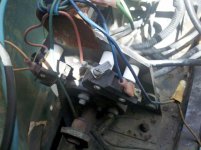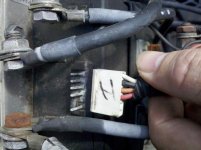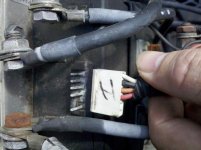Jay64
100 kW
I picked up an old golf cart for supper cheap. Was told it doesn't run, and that is the extent I know of what is wrong with it so far. There were no batteries in it, so I am hoping that they just died, and the previous owner didn't want to fork out the money for new ones. That might be a little unrealistic of a hope, but that's what I'm going on right now. :lol: It still has the motor, controller, and what looks like most of the electrical components. I figured that if the motor works, it probably would be worth what I paid for the whole thing. I think I'm going to jack the rear end up in the air and apply some power straight to the motor to just make sure that is at least working.
View attachment 3
The overall shape of the cart is pretty bad, but definately a decent place to work from. I am looking at fixing it up and trying some different stuff with it. I just started looking into the Florida NEV rules to see if I can make it streetable for running errands and such. So far I know I need a new left rear tire, but there is a shop close to me that sells used rims w used tires for $10. Figure I can't go wrong with that. I also know that I am definately going to have to replace the battery trays, as they are all rusted out. But depending on the batteries that I end up using, I would probably have to make some mods to this anyways, so that is no big deal.
View attachment 4
Not really sure exactly what this is, but I'm assuming that it is just to switch the motor back and forth between forward and reverse.
View attachment 1
The controller and what looks like a contactor are in pretty bad shape on the outside, but hopefully if I clean it all up, it will still work.
I believe that it is an EZ Go. Does anyone have any experience with this type of cart?
View attachment 3
The overall shape of the cart is pretty bad, but definately a decent place to work from. I am looking at fixing it up and trying some different stuff with it. I just started looking into the Florida NEV rules to see if I can make it streetable for running errands and such. So far I know I need a new left rear tire, but there is a shop close to me that sells used rims w used tires for $10. Figure I can't go wrong with that. I also know that I am definately going to have to replace the battery trays, as they are all rusted out. But depending on the batteries that I end up using, I would probably have to make some mods to this anyways, so that is no big deal.
View attachment 4
Not really sure exactly what this is, but I'm assuming that it is just to switch the motor back and forth between forward and reverse.
View attachment 1
The controller and what looks like a contactor are in pretty bad shape on the outside, but hopefully if I clean it all up, it will still work.
I believe that it is an EZ Go. Does anyone have any experience with this type of cart?








